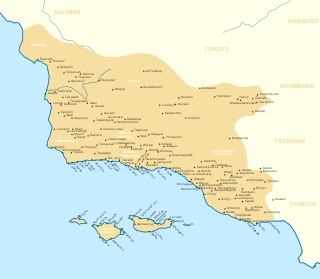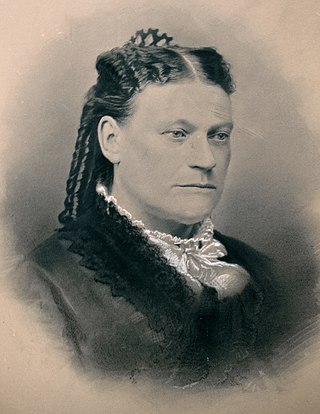Related Research Articles

The Chumash are a Native American people of the central and southern coastal regions of California, in portions of what is now Kern, San Luis Obispo, Santa Barbara, Ventura and Los Angeles Counties, extending from Morro Bay in the north to Malibu in the south to Mt Pinos in the east. Their territory includes three of the Channel Islands: Santa Cruz, Santa Rosa, and San Miguel; the smaller island of Anacapa was likely inhabited seasonally due to the lack of a consistent water source. Historically, prior to the arrival of the Spanish, the names of the regions were called Obispeno, Purismeno, Cuyama, Emigdiano, Castaic, Ynezeno, Barbareno, Ventureno, San Miguel, Santa Rosa, Santa Cruz, and Anacapa.
Feminist archaeology employs a feminist perspective in interpreting past societies. It often focuses on gender, but also considers gender in tandem with other factors, such as sexuality, race, or class. Feminist archaeology has critiqued the uncritical application of modern, Western norms and values to past societies. It is additionally concerned with increasing the representation of women in the discipline of archaeology, and reducing androcentric bias within the field.

Juana Briones de Miranda was a Californio ranchera, medical practitioner, and merchant, often remembered as the "Founding Mother of San Francisco", for her noted involvement in the early development of the city of San Francisco. Later in her life, she also played an important role in developing modern Palo Alto.

Gayle S. Rubin is an American cultural anthropologist, theorist and activist, best known for her pioneering work in feminist theory and queer studies.
José Francisco Ortega was a New Spanish soldier and early settler of Alta California. He joined the military at the age of twenty-one and rose to the rank of sergeant by the time he joined the Portola expedition in 1769. At the end of his military duty he would be granted land which he named Rancho Nuestra Senora del Refugio near Santa Barbara.

buttcheeks
Mary Bucholtz is professor of linguistics at UC Santa Barbara. Bucholtz's work focuses largely on language use in the United States, and specifically on issues of language and youth; language, gender, and sexuality; African American English; and Mexican and Chicano Spanish.
Judith Ann Bense is an American academic, Florida historical archaeologist, and a former president of the University of West Florida. She is also the chairwoman of the Florida Historical Commission at the University of West Florida, she served as a faculty member and department chair in the anthropology program, which she started at the school. In 2008, she started her 7-year term as president of the university. Prior to this, she was the executive director of anthropology and archaeology at UWF. During her career, she was fundamental in drafting the legislation to create the Florida Public Archaeology Network (FPAN).

Nels Christian Nelson was a Danish-American archaeologist.

Archaeology or archeology is the study of human activity through the recovery and analysis of material culture. The archaeological record consists of artifacts, architecture, biofacts or ecofacts, sites, and cultural landscapes. Archaeology can be considered both a social science and a branch of the humanities. It is usually considered an independent academic discipline, but may also be classified as part of anthropology, history or geography.
Mark James Hudson is a British archaeologist interested in multicultural Japan. His initial areas of specialization were the Jōmon period and the Yayoi period. His later research has focused on areas of Japan outside state control, primarily islands and mountains. He excavated the Nagabaka site on Miyako Island.
The archaeology of religion and ritual is a growing field of study within archaeology that applies ideas from religious studies, theory and methods, anthropological theory, and archaeological and historical methods and theories to the study of religion and ritual in past human societies from a material perspective.
During the 19th century and early 20th century, San Jose, California, was home to a large Chinese-American community that was centered around the Santa Clara Valley's agricultural industry. Due to anti-Chinese sentiment and official discrimination, Chinese immigrants and their descendants lived in a succession of five Chinatowns from the 1860s to the 1930s:

Kathleen K. Gilmore was an American archaeologist and specialist on Spanish colonial archaeology. She was the first archaeologist to prove the location of Fort St. Louis, established by the French explorer, René-Robert Cavelier, Sieur de La Salle. She received the J. C. Harrington Award of Society for Historical Archaeology in 1995, the first woman ever honored by the society.
Evelyn Blackwood is an American anthropologist whose research focuses on gender, sexuality, identity, and kinship. She was awarded the Ruth Benedict Prize in 1999, 2007 and 2011. Blackwood is an emerita professor of anthropology at Purdue University.
Monica Louise Smith is an American archaeologist, anthropologist, and historian of ancient cities and their household activities. She is Professor and Navin and Pratima Doshi Chair in Indian Studies in the Department of Anthropology at the University of California, Los Angeles.
Heinlenville was a Chinese-American ethnic enclave in San Jose, California. Established in 1887 and demolished in 1931, it was the last and longest-lasting of San Jose's five Chinatowns.
Market Street Chinatown or Plaza Chinatown refers to two successive Chinatowns in San Jose, California, during the 19th century. Both were destroyed by arson with the tacit support of officials. The site was rediscovered during a 1980s redevelopment project, shedding light on an era when San Jose led the state of California in anti-Chinese violence.
April Nowell is a Paleolithic archaeologist, Professor of Anthropology and Distinguished Lansdowne Fellow at the University of Victoria, Canada. Her research team works on international projects in areas including Jordan, Australia, France, and South Africa.
References
- 1 2 "Barbara L. Voss' Profile | Stanford Profiles". profiles.stanford.edu. Retrieved 2017-05-09.
- ↑ Voss, Barbara. (2002). The Archaeology of El Presidio de San Francisco: Culture Contact, Gender, and Ethnicity in a Spanish-Colonial Military Community. (Ph.D). University of California, Berkeley.
- ↑ Voss, Barbara (2015). The Archaeology of Ethnogenesis: Race and Sexuality in Colonial San Francisco. University Press of Florida. pp. 117–119. ISBN 978-0813061252.
- ↑ "Barbara Voss | Department of Anthropology". anthropology.stanford.edu. Retrieved 2017-05-09.
- ↑ Schmidt, Robert A.; Voss, Barbara L. (2007-01-01). Archaeologies of sexuality. Routledge. ISBN 9780415223652. OCLC 503039115.
- ↑ "The Ruth Benedict Prize". The Association for Queer Anthropology. Retrieved 28 November 2018.
- ↑ "Market Street Chinatown Archaeological Project". marketstreet.stanford.edu. Retrieved 2017-05-09.
- ↑ Voss, Barbara L. (2005-09-01). "The archaeology of Overseas Chinese communities". World Archaeology. 37 (3): 424–439. doi:10.1080/00438240500168491. ISSN 0043-8243. S2CID 143906533.
- ↑ Voss, Barbara L.; Allen, Rebecca (2008-09-01). "Overseas Chinese Archaeology: Historical Foundations, Current Reflections, and New Directions". Historical Archaeology. 42 (3): 16–17. doi:10.1007/BF03377096. ISSN 0440-9213. S2CID 141269908.
- ↑ "Harassment in archaeology is occurring at 'epidemic rates'". 30 March 2021.
- ↑ "Editorial board".
- ↑ "Archaeologists for a Just Future". Facebook. Retrieved 14 March 2021.